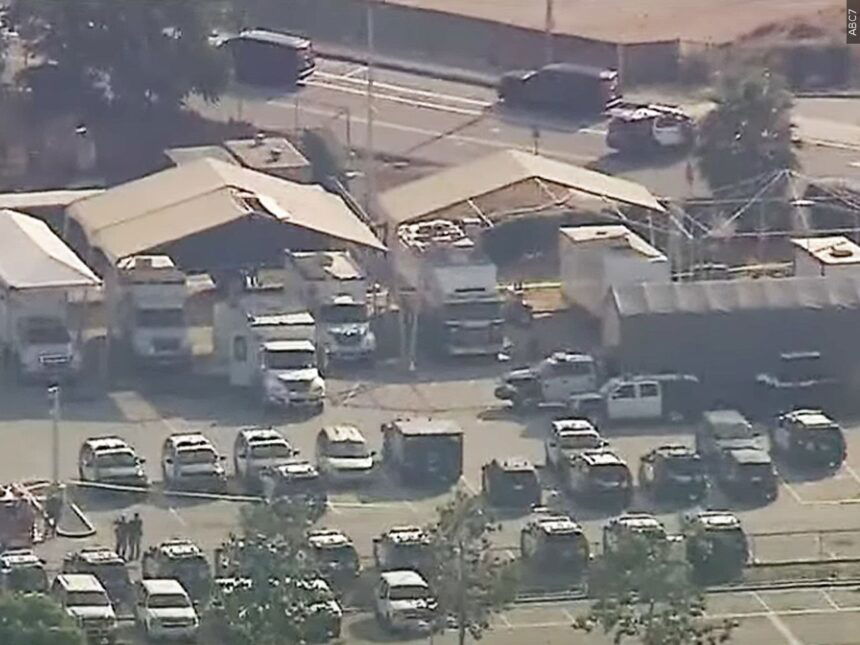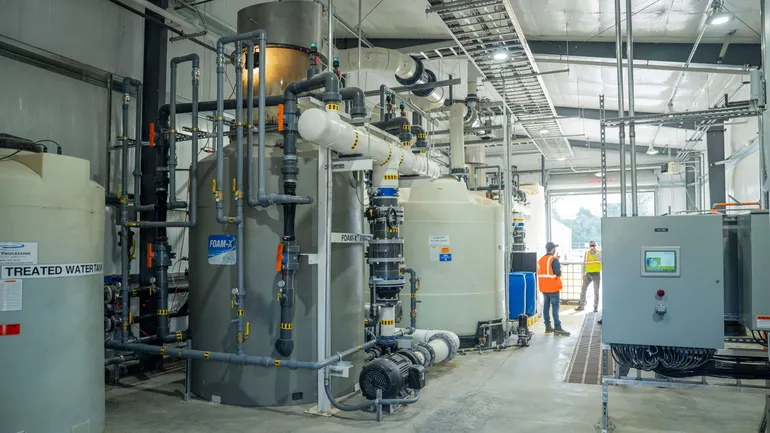US and Mexico agree to long-term wastewater treatment plan in the San Diego-Tijuana region – CNN

Report on the United States-Mexico Agreement for Wastewater Management in the Tijuana River Basin
Executive Summary
The governments of the United States and Mexico have formalized a memorandum of understanding to address the critical wastewater crisis in the Tijuana River basin. This binational agreement accelerates funding and implementation of essential water treatment infrastructure projects, directly contributing to several United Nations Sustainable Development Goals (SDGs). The initiative aims to mitigate severe public health risks and environmental degradation affecting communities on both sides of the border, representing a significant step towards achieving SDG 6 (Clean Water and Sanitation), SDG 3 (Good Health and Well-being), and SDG 17 (Partnerships for the Goals).
Addressing a Transboundary Environmental and Health Crisis
Public Health and Environmental Context
The Tijuana River, which flows from Mexico into the United States, carries untreated wastewater that poses a significant threat to human and environmental health. This long-standing issue directly contravenes the principles of SDG 3 and SDG 6.
- Health Impacts (SDG 3): Residents in proximity to the river have experienced severe health issues. Research has confirmed that contaminants, including chemicals from tires, personal care products, and illicit drugs, are becoming airborne, expanding the scope of public health concerns.
- Water Contamination (SDG 6, SDG 14, SDG 15): The continuous flow of untreated sewage pollutes not only the river itself but also coastal waters and local ecosystems, undermining efforts to ensure clean water, protect life below water, and sustain life on land.
The Binational Agreement: A Framework for Action
Key Commitments and Objectives
The agreement, signed by the US Environmental Protection Agency and Mexico’s Secretariat of Environment and Natural Resources, establishes a concrete action plan to be executed by 2027. This partnership is a prime example of SDG 17 in action, leveraging international cooperation to solve a shared challenge.
- Renewed Financial Commitment: Both nations will allocate funds for the construction of new wastewater treatment facilities and the renovation of existing infrastructure.
- Project Acceleration: The memorandum expedites the timeline for several key infrastructure projects, aiming for completion within the next two years.
- Cost-Sharing Framework: The agreement reaffirms commitments outlined in Minute 328 of the International Water and Boundary Commission (IBWC), which details how the US and Mexico will share operational and maintenance costs.
- Targeted Infrastructure Upgrades: A primary focus is the upgrade of the San Antonio de los Buenos treatment plant near Tijuana, with an estimated cost of $67 million, which the nations aim to split equally.
Direct Contributions to the Sustainable Development Goals (SDGs)
SDG 6: Clean Water and Sanitation
The agreement is fundamentally aligned with SDG 6, which calls for ensuring the availability and sustainable management of water and sanitation for all. Key contributions include:
- Target 6.3: Improving water quality by reducing pollution, eliminating dumping, and halving the proportion of untreated wastewater.
- Target 6.5: Implementing integrated water resources management at all levels, including through transboundary cooperation as demonstrated by this agreement.
SDG 3: Good Health and Well-being
By tackling the root cause of waterborne and airborne pollutants, the initiative directly supports SDG 3 by aiming to substantially reduce the number of illnesses and deaths from hazardous chemicals and water contamination.
SDG 17: Partnerships for the Goals
This memorandum exemplifies a robust North-South and bilateral partnership for sustainable development. It enhances policy coherence and mobilizes financial resources and technology to address a critical sustainable development challenge, in line with Target 17.16 (Enhance the global partnership for sustainable development) and Target 17.17 (Encourage and promote effective public, public-private and civil society partnerships).
Broader Sustainability Impacts
- SDG 11 (Sustainable Cities and Communities): The project will improve the environmental quality and safety of urban areas in the San Diego-Tijuana region.
- SDG 14 (Life Below Water): Reducing the flow of pollutants into the Pacific Ocean will help protect marine and coastal ecosystems from land-based activities.
Conclusion
The US-Mexico wastewater agreement represents a critical and strategic advancement in regional environmental management. By formalizing financial commitments and accelerating project timelines, both nations are taking decisive action to protect public health, restore ecological integrity, and build resilient communities. This initiative serves as a powerful model for transboundary cooperation and demonstrates a tangible commitment to achieving the 2030 Agenda for Sustainable Development, with profound positive implications for SDG 3, SDG 6, and SDG 17.
SDGs Addressed in the Article
- SDG 3: Good Health and Well-being
- SDG 6: Clean Water and Sanitation
- SDG 9: Industry, Innovation and Infrastructure
- SDG 14: Life Below Water
- SDG 17: Partnerships for the Goals
Specific Targets Identified
-
SDG 3: Good Health and Well-being
- Target 3.9: By 2030, substantially reduce the number of deaths and illnesses from hazardous chemicals and air, water and soil pollution and contamination.
Explanation: The article directly links the untreated wastewater to public health crises, stating that “Residents living along the river have long battled severe health issues which researchers say stem from the river’s contamination.” It also notes that waterborne chemicals are “being introduced into the air — exacerbating health concerns for tens of thousands of residents.”
- Target 3.9: By 2030, substantially reduce the number of deaths and illnesses from hazardous chemicals and air, water and soil pollution and contamination.
-
SDG 6: Clean Water and Sanitation
- Target 6.3: By 2030, improve water quality by reducing pollution, eliminating dumping and minimizing release of hazardous chemicals and materials, halving the proportion of untreated wastewater and substantially increasing recycling and safe reuse globally.
Explanation: The central theme of the article is the agreement to “fund and expedite several wastewater treatment projects” to address the problem of “untreated wastewater” flowing across the border. The goal is to “resolve once and for all the problem of wastewater from the Tijuana River.” - Target 6.5: By 2030, implement integrated water resources management at all levels, including through transboundary cooperation as appropriate.
Explanation: The article is about a bilateral agreement between the “governments of Mexico and the United States” to manage a shared resource, the “Tijuana River basin.” The memorandum of understanding and the reference to “Minute 328” are direct examples of transboundary cooperation for water management. - Target 6.a: By 2030, expand international cooperation and capacity-building support to developing countries in water- and sanitation-related activities and programmes, including water harvesting, desalination, water efficiency, wastewater treatment, recycling and reuse technologies.
Explanation: The agreement involves the US and Mexico committing to “funding the construction and renovation of water treatment infrastructure on both sides of the border,” which represents international cooperation and financial support for sanitation-related activities.
- Target 6.3: By 2030, improve water quality by reducing pollution, eliminating dumping and minimizing release of hazardous chemicals and materials, halving the proportion of untreated wastewater and substantially increasing recycling and safe reuse globally.
-
SDG 9: Industry, Innovation and Infrastructure
- Target 9.1: Develop quality, reliable, sustainable and resilient infrastructure, including regional and transborder infrastructure, to support economic development and human well-being, with a focus on affordable and equitable access for all.
Explanation: The agreement focuses on the “construction and renovation of water treatment infrastructure” and upgrading the “critical San Antonio de los Buenos treatment plant.” This is a direct investment in developing resilient, transborder sanitation infrastructure.
- Target 9.1: Develop quality, reliable, sustainable and resilient infrastructure, including regional and transborder infrastructure, to support economic development and human well-being, with a focus on affordable and equitable access for all.
-
SDG 14: Life Below Water
- Target 14.1: By 2025, prevent and significantly reduce marine pollution of all kinds, in particular from land-based activities, including marine debris and nutrient pollution.
Explanation: The Tijuana River flows into the Pacific Ocean. The article mentions that addressing the water contamination will ensure a safer environment for those “training on nearby beaches,” implying that the river’s pollution is affecting the coastal and marine environment.
- Target 14.1: By 2025, prevent and significantly reduce marine pollution of all kinds, in particular from land-based activities, including marine debris and nutrient pollution.
-
SDG 17: Partnerships for the Goals
- Target 17.16: Enhance the global partnership for sustainable development, complemented by multi-stakeholder partnerships that mobilize and share knowledge, expertise, technology and financial resources, to support the achievement of the sustainable development goals in all countries, in particular developing countries.
Explanation: The entire article describes a bilateral partnership between the US and Mexico, formalized through a “memorandum of understanding,” to address a shared environmental and health problem. It involves shared funding, expertise, and a commitment to joint action.
- Target 17.16: Enhance the global partnership for sustainable development, complemented by multi-stakeholder partnerships that mobilize and share knowledge, expertise, technology and financial resources, to support the achievement of the sustainable development goals in all countries, in particular developing countries.
Indicators for Measuring Progress
-
For Target 6.3 (Improve water quality)
- Implied Indicator: Proportion of wastewater safely treated. The article’s focus on building and renovating “wastewater treatment projects” to deal with “untreated wastewater” implies that a key measure of success will be the volume and proportion of wastewater that is treated before being discharged.
- Implied Indicator: Concentration of pollutants in the river and air. The article mentions “trace amounts of waterborne chemicals from tires, personal care products, and even illicit drugs.” Measuring the reduction of these specific contaminants in the water and surrounding air would be a direct indicator of progress.
-
For Target 3.9 (Reduce illnesses from pollution)
- Implied Indicator: Incidence of illnesses related to water and air contamination in communities along the river. The article highlights that residents “have long battled severe health issues.” Tracking health data in these communities to see a reduction in such illnesses would be a key indicator.
-
For Target 6.5 (Transboundary cooperation)
- Mentioned Indicator: Existence of an operational arrangement for water cooperation. The “memorandum of understanding” and the reaffirmation of “Minute 328” serve as direct evidence of an operational arrangement for the transboundary Tijuana River basin.
-
For Target 9.1 (Develop resilient infrastructure)
- Mentioned Indicator: Investment in and completion of infrastructure projects. The article explicitly mentions the goal to complete projects by 2027 and the specific cost for upgrading the San Antonio de los Buenos plant ($67 million). Tracking the funds allocated and the completion of these construction and renovation projects are direct indicators.
-
For Target 17.16 (Partnerships)
- Mentioned Indicator: Financial resources committed to the partnership. The article mentions a specific cost-sharing plan where “the US and Mexico each cover half the costs” for one plant, estimated at “$67 million.” The total amount of funds committed and disbursed by both countries is a measurable indicator of the partnership’s effectiveness.
SDGs, Targets, and Indicators Analysis
| SDGs | Targets | Indicators (Mentioned or Implied) |
|---|---|---|
| SDG 3: Good Health and Well-being | 3.9: Substantially reduce illnesses from hazardous chemicals and water pollution. | Incidence of waterborne diseases and other health issues in communities along the Tijuana River. |
| SDG 6: Clean Water and Sanitation | 6.3: Improve water quality by reducing pollution and halving the proportion of untreated wastewater. | Proportion of wastewater safely treated; Reduction in the concentration of specific chemical pollutants in the water and air. |
| 6.5: Implement integrated water resources management, including through transboundary cooperation. | Existence and implementation of the US-Mexico memorandum of understanding and “Minute 328” for the Tijuana River basin. | |
| 6.a: Expand international cooperation and capacity-building support for water and sanitation. | Amount of funding committed by the US and Mexico for wastewater treatment infrastructure. | |
| SDG 9: Industry, Innovation and Infrastructure | 9.1: Develop quality, reliable, and resilient transborder infrastructure. | Number of wastewater treatment plants constructed or renovated; Completion of specific projects like the San Antonio de los Buenos plant upgrade. |
| SDG 14: Life Below Water | 14.1: Prevent and significantly reduce marine pollution from land-based activities. | Improved water quality and safety on nearby beaches affected by the river’s discharge. |
| SDG 17: Partnerships for the Goals | 17.16: Enhance the global partnership for sustainable development. | Financial resources committed under the bilateral agreement (e.g., the $67 million cost-sharing plan). |
Source: cnn.com

What is Your Reaction?
 Like
0
Like
0
 Dislike
0
Dislike
0
 Love
0
Love
0
 Funny
0
Funny
0
 Angry
0
Angry
0
 Sad
0
Sad
0
 Wow
0
Wow
0











































































